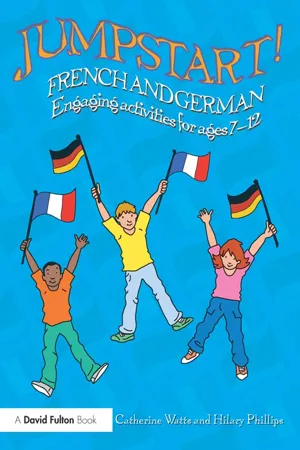
Jumpstart! French and German
Engaging activities for ages 7-12
- 144 pages
- English
- ePUB (mobile friendly)
- Available on iOS & Android
About This Book
Jumpstart! French and German presents a collection of simple to use, multi-sensory games and activities that will jumpstart students' understanding of modern languages in action. If you are one of the thousands of teachers looking for a range of practical and fun ideas to teach languages engagingly, then this is the perfect book for you.
The book opens with a range of innovative ideas to help you set the scene in your language classroom. These are followed by a feast of short and simple activities designed to help you make quick starts with your students and hold their attention. The focus throughout is on communicative action, bringing languages alive with all activities presented in two languages: French and German. Specifically written to help teachers work within the guidelines of the new curriculum, activities in the book will help pupils to: -
• Listen, respond and understand key elements of the target language
• Speak in phrases and sentences with appropriate pronunciation
• Express and communicate simple ideas with clarity
• Write phrases and short sentences
• Develop an understanding of basic grammar
• Learn songs and simple poems in the language studied
• Engage in active learning through a range of varied activities.
Jumpstart! French and German celebrates the joys of language and will help you to find just the right words or phrases to express what you want to say.
Frequently asked questions
Information
Setting the Scene
ADDING LANGUAGE TO EXISTING CLASSROOM ROUTINES
EnglishGood morning. How are you? I’m fine thanks.FrenchBonjour les enfants. Bonjour Monsieur/Madame.Comment ça va? Ça va bien, merci.GermanGuten Morgen. Wie geht’s? Gut, danke.
Registers
EnglishSchool dinner or packed lunch, Joshua?School dinner please, Madame.Enjoy your meal!FrenchLa cantine ou les sandwiches, Joshua?La cantine s’il vous plaît, Madame.Bon appétit!GermanDie Kantine oder belegte Brote?Die Kantine bitte, Frau X.Guten Appetit!
Counting activities
Using assembly time
Table of contents
- Cover
- Half Title
- Title Page
- Copyright Page
- Dedication
- Table of Contents
- Vocabulary Topics
- List of figures
- Acknowledgements
- Introduction
- 1 Setting the Scene
- 2 Using Flashcards
- 3 Quick Starts
- 4 On Your Feet
- 5 Being Creative
- 6 Using Songs
- 7 Exploring Stories
- 8 Showing the World
- 9 Starting to Write
- 10 At the End of the Day
- Appendix 1: French and German Alphabets
- Appendix 2: Useful Classroom Language
- Appendix 3: Praise, Encouragement and Being Polite
- Bibliography